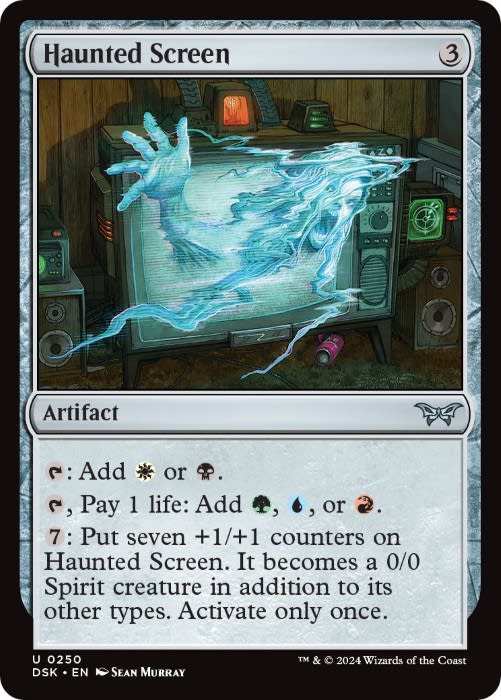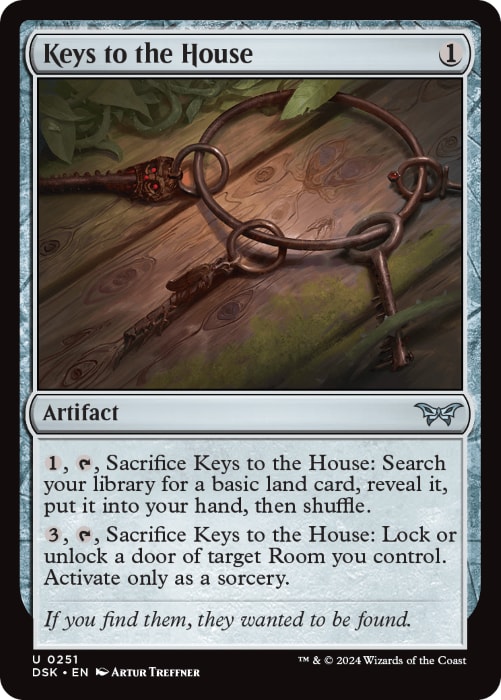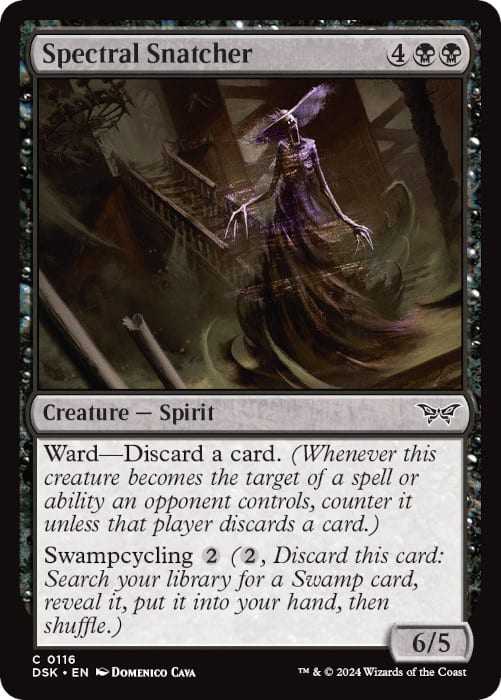This past weekend I got the chance to play in two prereleases for Magic's next mainline set, Duskmourn: House of Horror. While I was skeptical of this set at first, since I had my doubts about a horror set ever coming close to the triumph that is Innistrad, I was pleasantly surprised by both the aesthetic and gameplay of Duskmourn. While Duskmourn is full of some pretty on the nose horror movie tropes, there are definitely some disturbing cards that make my skin crawl.
When it comes to play, Duskmourn has everything I want in a Magic set from a Limited perspective. With solid fixing, grindy mechanics, alternate ways to win games besides attacking, and overlapping archetypes, I'm hopeful Duskmourn will be an enjoyable draft environment. While I only got to play six matches across two events, I did take away some lessons about the format from my experience and that of my friends.
Lesson #1 - The Fixing is Incredible
Looking at Duskmourn's card image gallery, it's pretty easy to understand why fixing is so easy in this set, especially in Sealed. In addition to the cycle of ten common dual lands, cycle of five rare allied dual lands, and Terramorphic Expanse, there are a huge number of mana-fixers in both Green and Colorless. Here are some of the many examples in this set:
Not to mention the cycle of mana cycler creatures:
This means that games will be slower than in non-dual land formats, and that there's a higher likelihood you can splash cards in your pool or draft more multicolored cards that share your deck's base colors.
For example, one of my prerelease decks was base Blue-Black, but due to the number of dual lands and Terramorphic Expanses I had, in addition to a Haunted Screen, I was easily able to splash The Swarmweaver, Victor, Valgavoth's Seneschal, and two copies of Roaring Furnace // Steaming Sauna. However in my other prerelease my deck was base Black-White splashing Green for Broodweaver and Drag to the Roots - I didn't want to splash too many cards since I had mana-intense costed cards like Rite of the Moth.
Formats like Duskmourn with so much fixing available can give you lots of access to splash multicolored uncommons, removal spells, or some of the dual-colored room enchantment cards special to this set. I think you can easily go 3+ colors in Sealed while also having room to splash cards in Draft as well. The amount of colors you can splash in Draft will be more dependent on how fast some of the aggro decks of the format are, like Green-White Survival and Gruul Delirium aggro.
Lesson #2 - Many Cards are Multifunctional
After losing a Black-White mirror in my first event, I became incredibly impressed with the card Fear of Immobility. Taking another look at the card, I made a couple mental notes on why this card was so impressive.
- It's both a creature and enchantment, which counts for two card types for Delirium
- It acts both as an aggressive or defensive card, either tapping down your opponent's best blocker or tapping their best attacker
- You can tap your own creature that has a Survival effect
- It can trigger your Eerie cards
For a common, I'm blown away by how multipurpose this card is. It seems like the perfect common you'd slot into a number of archetypes that can fill a variety of roles in a given game. While this obviously isn't the most powerful card in the set, it's worth noting how a card like this can be so versatile.
In Bloomburrow, for example, a card like Kindlespark duo is also a card that is versatile, but in this case this card is much more narrow. Kindlepsark Duo is first and foremost a Rakdos and Izzet card. Since Rakdos Lizards benefits off you dealing damage to your opponent, and Izzet Otters benefits off you casting noncreature spells, this card fills a role in not one, but two archetypes. However, this card is much worse in a deck like Boros Mice which is more focused on triggering Valiant and attacking with high power creatures. It's also weak in Gruul Raccoons, since this creature isn't a good attacker and has no benefit with the Expend theme in that archetype. So while this card appears Red on the surface, it's actually a Rakdos and Izzet card primarily, since it's much worse in the other Red archetypes of the set.
Duskmourn, however, seems way more lax as a Limited format in what your two-color combination has to be. White-Black is reanimator, White-Red is aggro, White-Blue is Eerie, White-Green is survival - and this card fits into all of those archetypes. Overall, the lesson you should take from a card like Fear of Immobility is how to find the most value and cross-functionality in a set that has so many mechanics. While Duskmourn does ten two-color archetypes, I like that cards don't feel as restricted to one or two two-color decks in this format, with Fear of Immobility being a fantastic example of this.
Lesson #3 - When to Play More than 40 Cards
While the Duskmourn Limited format is still in its infancy, just based on the design of the set and my experience at prerelease this set feels very grindy. We can extrapolate data from previous similar Limited sets, like Shadows Over Innistrad, which also had Delirium as a core mechanic. Shadows was a grindy format, with mechanics like Investigate and Delirium which made games inevitably come down to the wire. There were lots of value engines, like Ongoing Investigation and Fleeting Memories that helped you to gain an advantage over your opponent.
Duskmourn is different from a slower set like Shadows in that it has pretty beefy and hasty creatures in the Naya colors. I think while the format is slower overall, you can still get run over by cards like Veteran Survivor and Acrobatic Cheerleader.
However, I do think there are times where you want to build your deck or sideboard in a way to out-value your opponent, or out-live them. Duskmourn is a format that inherently has a lot of self-mill. Every time you Manifest Dread, you essentially remove two cards from your library. Combine Manifest Dread with cards like Commune with Evil or Threats Around Every Corner, and you could find yourself in games where you might mill yourself out.
There are two things you have to keep in consideration if your deck churns out cards quickly - when you should play more than 40 cards, and keeping track of when you shouldn't dig deeper into your deck. I don't think it's necessarily wrong to play 41/42 cards, especially if you're a grindy three-color or more deck with lots of removal, value creatures, or Manifest Dread effects. It's also worth putting into consideration how your opponent might be able to interact with your library.
In a dedicated Blue-Black Eerie deck, Scrabbling Skullcrab seems like the bane of Manifest Dread decks' existence. While you may want as much value as possible in this set, it's worth keeping track of how many self-mill effects you have in your deck, and whether or not it might be correct to go up a couple cards in a given match, so you don't deck out before your opponent does.
Lesson #4 - Delirium is Easy to Assemble
The last lesson I learned from prerelease is that Delirium is incredibly easy to assemble in this format. With multiple cards sharing two card types, like Fear of Immobility which I mentioned earlier, you can easily fill your graveyard to hit Delirium. I remember I had an active Osseous Sticktwister by turn four in one of my matches, solely due to the fact I had a Terramorphic Expanse and an Overlord of the Balemurk. With surveil taking over scry as a way to manipulate top cards of your library in recent sets it's become so much easier to hit Delirium in early portions of the game.
What this means for Limited is that I now value Delirium cards higher than I did at first glance. Spineseeker Centipede on the service is just a worse Borderland Ranger, but based on the nature of this set more often than not this card will be a 3/3, especially in the Green-Red and Green-Black decks of this set.
Let's Play a Game is a card I haven't played with yet, but one I'll be valuing very highly, especially in the Black-White Reanimator archetype of this set. Since Black-White already cares about putting cards into the graveyard to reanimate back to play, you'll inevitably end up with cards in your graveyard, either via surveilling them away or using mana cyclers like Spectral Snatcher. Overall, it seems fairly easy to obtain value from your Delirium cards, even as early as turn three or four in this set.
Overall, prerelease was super fun to attend as always, and I learned a lot about Magic's next Limited environment. For both events I went to at Odyssey Games in Pasadena, CA, there was a promotion where if you showed up in costume you'd get a free promo pack...
My local #MTGDuskmourn prerelease gave promo packs to people in costume, so I put together a makeshift Geralf cosplay! Monocle by @bunniesandbroomsticks pic.twitter.com/ITalh3Z3jt
-- Roman Fusco (@roman_fusco) September 21, 2024
I had a ton of fun dressing up as Geralf, putting together a pretty last minute costume via clothing I found on Amazon with the added help of my partner putting together (stitching together?) Geralf's classic monocle.
-Roman Fusco



































